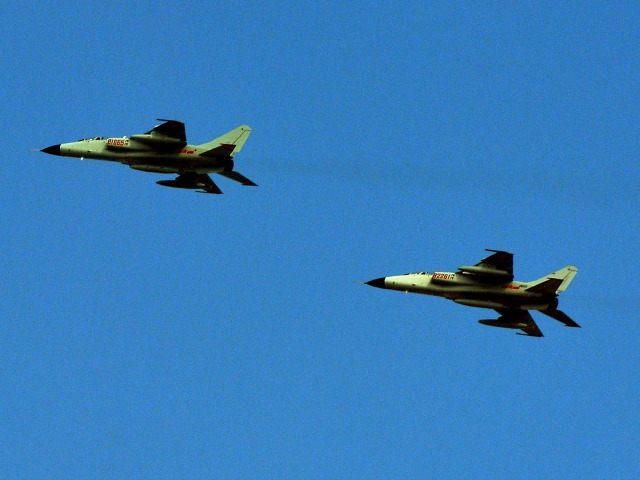A report surfacing after a long day of talks between Chinese Foreign Minister Wang Yi and Secretary of State John Kerry claims China has placed up to ten fighter jets in the Paracel Islands, disputed territory in the South China Sea. The report follows satellite evidence that Beijing has added surface-to-air missiles and an advanced radar system to its arsenal in the region.
American intelligence sources report that they have evidence of the presence of no more than ten fighter jets of the Chinese Shenyang J-11s (“Flanker”) and Xian JH-7s (“Flounder”) varieties on Woody Island, an island the Chinese government has been expanding and constructing on illegally over the past year. The Paracel Islands are claimed by Vietnam as well as China, and the waters surrounding them are considered international territory. China has long disputed this, arguing that Beijing should have full maritime control in the region despite having no known legitimate claim to the region.
The United States has responded to the report with caution. Capt. Darryn James, a spokesman for U.S. Pacific Command, told the Wall Street Journal that the deployment of fighter jets to Woody Island “is not a surprise,” and military development there “has been going on for the last few years.” He nonetheless described these developments as “disturbing.” The Pentagon reacted similarly, with a spokesman telling the Wall Street Journal that the U.S. military is more concerned with the “signal it sends of how far out of step China’s actions are with the aspirations of the region” than the ability of the fighter jets to cause harm themselves.
The Wall Street Journal notes the Chinese Foreign Ministry has neither confirmed nor denied the deployment.
Last week, Chinese activity on Woody Island made similar headlines as satellite images shows that the government had placed an advanced surface-to-air missile system there, a defensive move with no overt civilian use. China has long maintained its development of South China Sea islands to be for civilian purposes. In the Spratly Islands, contested by the Philippines, China has begun constructing an advanced radar system that would greatly expand its surveillance abilities in the region.
Following that announcement, Secretary Kerry vowed “very serious” talks with his Chinese counterpart on demilitarizing the region. Yet in public remarks following their meeting Tuesday, Kerry appeared to warn all the nations of the region, not just China, away from militarization. There is no evidence that Vietnam, the Philippines, Malaysia, Brunei, or Taiwan – the other nations with territorial claims in the South China Sea – are similarly constructing military facilities in disputed territory.
“We think everybody benefits by true demilitarization, non-militarization. We also urge people to clarify the territorial and maritime claims in accordance with international law,” Kerry told the press, adding, “It is important for all of the nations – China, Philippines, Vietnam, others – not to engage in any unilateral steps of reclamation, of building, of militarization. And the fact is that there have been steps by China, by Vietnam, by others that have unfortunately created an escalatory cycle.”
Wang also accused other nations of “illegal” occupation of territory in the South China Sea. “The South China Sea islands have historically been China’s territory. China has a right to uphold its territorial integrity and lawful, legitimate maritime rights and interests,” he said. He emphasized that he wanted the United States to play no part in this dispute: “The South China Sea issue is not and should not become an issue between China and United States.”
While Wang did not specify what he meant by illegal militarization in the region, Chinese state media was quick to accuse the United States of prompting China’s occupation of these territories through its legal development of military facilities in the Pacific generally. “The true examples of militarization can be found in Okinawa and Guam, which are heavily garrisoned by the US, whose projection of power can extend in a radius of thousands of kilometers,” a column in the state-controlled Global Times alleges. “They serve Washington’s military hegemony as pivots. China meanwhile only updates its facilities on these islands from anti-aircraft artillery to HQ-9 missiles, and from telescopes to radar. They are solely for defense,” it adds.
In the People’s Daily, another Beijing-controlled publication, an “anonymous researcher” is recruited to accuse the United States of “exaggerat[ing] threats from China in order to have an excuse to put a finger in the South China Sea.” The article acknowledges Chinese militarization in the region.

COMMENTS
Please let us know if you're having issues with commenting.